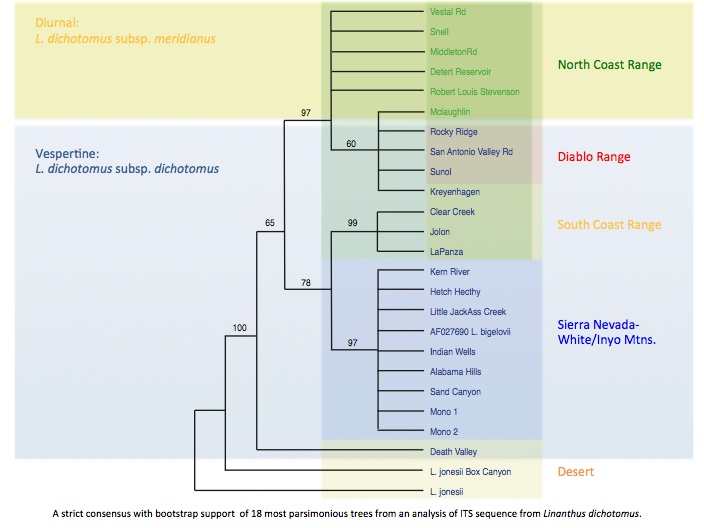Linanthus dichotomus

SCOTT SIMONO
Erin Rentz
Introduction:
Linanthus dichotomus Benth (Polemoniaceae), known as Evening Snow, consists of two subspecies, L. dichotomus subsp. dichotomus and L. dichotomus subsp. meridianus. Linanthus dichotomus subsp. dichotomus is a vespertine bloomer occurring throughout much of California south of the San Francisco Bay Area, to Nevada and Arizona. Linanthus dichotomus subsp. meridianus is a diurnal bloomer restricted to a few counties in northern California(1). Linanthus dichotomus subsp. meridianus was recognized by Alice Eastwood in 1945 based on this difference in blooming time(2). As part of a systematic study of the evolution of day and night blooming L. dichotomus I focused on the relationships between populations of the same subspecies, and between the day and night blooming subspecies by analyzing sequence data from the ITS region of nuclear ribosomal DNA.
Methods:
Twentyfour populations of Linanthus in California were identified and sampled (fig. 2). DNA was extracted and the ITS1 and ITS2 regions of the genome were amplified. Sequences were aligned manually using Sequencher 3.1.1 (5). Additional sequence data was obtained from GenBank (6). Maximum parsimony analysis using a heuristic search with 100 replicates and maximum parsimony bootstrap analysis with full heuristics and 1000 replicates were performed with PAUP*(7).
Results:
Phylogenetic analysis of ITS regions 1 and 2 resulted in 18 minimum-length trees of 61 steps. A strict consensus of these trees with bootstrap support is presented in Figure 1. Using L. jonesii as the outgroup, two distinct clades were apparent: A primarily northern California clade, including all of the day blooming populations of L. dichotomus subsp meridianus, and a clade encompassing the South Coast Range, the Sierra Nevada and White and Inyo Mountains. L. dichotomus subsp. meridianus appears polyphyletic but the relationship between day and night blooming populations remains relatively unresolved. The southern clade was further divided into two monophyletic groups supported by high boot strap values: 1) Western interior South Coast Range populations and 2) Eastern populations of the Sierra Nevada//White/Inyo Mountains and their desert margins.
Conclusions:
Of the closely related L. bigelovii, L. jonesii and L. dichotomus, L. dichotomus subsp meridianus, is the only diurnal bloomer. It has been speculated that night blooming is a basal character in the lineage and that day blooming might be derived. The molecular evidence does not contradict this, but it does not support day blooming as a character defining a monophyletic clade. Further sampling of both day and night blooming populations of Linanthus dichotomous and closely related taxa along with additional gene regions may provide a clearer picture of the evolutionary relationship of the day blooming trait.
FIGURE 1
FIGURE 2
livepage.apple.comlivepage.apple.com
References:
1. Jepson, Willis Linn. 1940. A Flora of California, Vol. 3 part 2. UC Berkeley, California, pp. 203-205.
2. Abrams, Leroy. 1951, 1967. Illustrated Flora of the Pacifiic States, vol. 3. Stanford University Press, California, pp 421-423.
3. Bell, Chuck, Robert Patterson and Laura Hamilton. 1999. Sectional Integrity in Lananthus (Polemoniaceae): A Molecular
Phylogeny of Section Dianthoides. Systematic Botany 24(4): pp. 632-644.
4. Bell, Chuck and Robert Patterson. 2000. Molecular Phylogeny and Biogeography of Linanthus (Polemoniaceae). American
journal of Botany 87 (12): pp. 1857-1870.
5. Gene Codes Corporation, Inc. Sequencher 3.1.1. Madison, Wisconsin, USA.
6. Bell, C.D. and Patterson, R. AF027690: Linanthus bigelovii. Gen Bank, National Center for Biotechnology Information.
http://www.ncbi.nlm.nih.gov/nuccore/AF027690.1 2004.
-
7.Swofford, D.L.2000. Paup*: Phylogenetic analysis using Parsimony. 4.0b10. Sinauer, Sunderland, Massachussets, USA.
A special thanks to Erin Rentz who began this project.

















